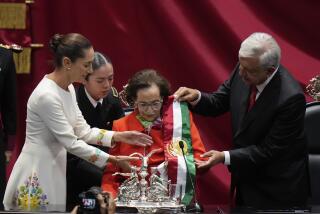Zapatista Addresses Mexico City Conclave
- Share via
MEXICO CITY — She appeared as tiny as a 12-year-old, with a quivering, girlish voice. But Commander Ramona sent a powerful message Friday as the black-masked Indian woman became the first leader of the Zapatista rebels to take their campaign to the nation’s capital.
“I come from the mountains of southeast Mexico--from the Zapatista rebel mountains--to bring you all a message,” she said to a cheering Indian conference here.
“We insist that this bad government provide democracy, liberty and justice for all Mexicans,” she added to thunderous applause.
The arrival of Commander Ramona marked a triumph for the Zapatista National Liberation Army, which launched a brief uprising on New Year’s Day 1994 but had not previously been allowed to travel beyond the southern state of Chiapas.
The government initially threatened to detain any rebel who accepted an invitation to address the conference. Arrest warrants for those involved in the 1994 rebellion were suspended as part of peace talks that opened two years ago.
Coming after a recent breakdown in the talks between the rebels and the government, the standoff over the trip raised fears of escalating tensions in southern Mexico.
But after three days of negotiations, a Zapatista representative was allowed to attend.
The choice: the tiny, 34-year-old Commander Ramona, whom the Zapatistas have said is dying of kidney cancer. Visiting the conference, which attracted representatives of most of Mexico’s 96 Indian tribes, was her dying wish, said Subcommander Marcos, the charismatic leader of the Zapatistas.
Ramona, a member of the rebels’ clandestine ruling committee, had never visited the Mexican capital before, nor traveled on an airplane. Reading her speech, she spoke haltingly and stumbled over words, later offering an apology for her poor reading ability.
It didn’t detract from the force of her message.
“We are going to support all of you,” the rebel leader told an auditorium filled with Indians in cowboy hats or bright embroidered shirts. “We know that what you want is to continue fighting so that all indigenous peoples can live as human beings--and not like animals, as the powerful people have kept us.”
She was greeted in Mexico City like a rock star. At the airport, where she arrived on a plane from Chiapas, hundreds of students yelled “Welcome Ramona!”
Later, when her chartered bus reached the downtown site of the conference, it was mobbed by TV cameras, Indian activists and young people in jeans. Some supporters tossed flowers.
William Means, a Lakota Indian from the Pine Ridge Indian Reservation in South Dakota, said the diminutive rebel was an inspiration to those attending the gathering.
“She’s a great symbol of the resistance and the struggle and the survival of the Indian people in Mexico,” he said.
The Zapatistas captured widespread public support in Mexico and abroad when their uprising took place. But as peace talks have dragged on, they have lost some of their appeal.
The talks broke down recently after a more radical group, the Popular Revolutionary Army, appeared in a series of bloody attacks across Mexico.
Analysts say the negotiations between the Zapatistas and the government have been strained because neither side wants to make concessions that would cause it to appear weak at the time of a new rebel threat.
While Ramona’s visit will probably not alter the delicate relationship between the government and the rebels, it could be a boost for the Zapatistas nonetheless, political scientist Denise Dresser said.
“It gives the Zapatistas a tool that had been successful in the past,” she said, referring to the rebels’ adroit exploitation of the media.
“It fuels renewed interest in the Zapatistas . . . who had pretty much disappeared from the public fray.”
Sheridan is a Times staff writer; Sundman is a special correspondent.
More to Read
Sign up for Essential California
The most important California stories and recommendations in your inbox every morning.
You may occasionally receive promotional content from the Los Angeles Times.










